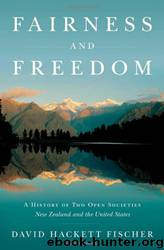Fairness and Freedom by David Hackett Fischer

Author:David Hackett Fischer
Language: eng
Format: epub
ISBN: 9780199912957
Publisher: Oxford University Press
Anti-Nuclear Diplomacy: The Rupture Between New Zealand and the United States
As these domestic difficulties increased, the Cold War alliance began to come apart. New Zealanders grew increasingly unhappy with American foreign policy. Prime Minister Norman Kirk made a point of not visiting the United States during the Nixon years, except to address the United Nations.87 The Carter administration angered New Zealanders in another way. It raised the ethical tone in Washington, but Prime Minister Robert Muldoon complained about President Carter’s “habits of making far-reaching decisions without consultation, and then expecting his friends and allies to back him up.”88
A growing source of conflict was the question of nuclear weapons, an issue of deep concern in New Zealand, in part because three nuclear powers did much of their testing in the South Pacific. The United States had exploded atomic and hydrogen bombs on the islands of Eniwetok and Bikini in 1952 and 1954. France also conducted its major tests in the South Pacific after Algeria won its independence in 1962. British Prime Minister Anthony Eden attempted to test nuclear weapons on islands that belonged to New Zealand without even bothering to notify New Zealanders. The result was an explosion of anger throughout the antipodes.89
The antinuclear campaign has been interpreted as an expression of a new intensity of independence in foreign relations, with a particular concern about the Pacific environment, which was being polluted by the nuclear tests of France, Britain, and the United States. But something else was going on here.90 The peace movement gathered new strength in the early 1980s, when the Reagan administration changed the foreign policy of the United States. It abandoned the doctrine of containment and began to speak of the destruction of the “Evil Empire” in the Soviet Union. Military spending increased, and the Reagan administration deployed a new generation of forward-placed Pershing missiles, which were designed to destroy “command and control” in a way that Soviet leaders perceived as a “first strike” capability. International tensions increased sharply, and the antinuclear movement surged throughout the Western world. It gathered strength in the United States, where university towns adopted their own foreign policy. The city of Cambridge, Massachusetts, unilaterally declared itself a nuclear-free zone, much to the fury of the city of Washington.
New Zealanders began to oppose visits by nuclear-powered warships of the United States Navy unless the American government accepted liability for any accident. To the disappointment of the antinuclear movement, the United States willingly agreed to do so. Antinuclear leaders changed their position and insisted that visits by all nuclear-powered, nuclear-armed, and “nuclear-capable” ships were unacceptable. Labour Prime Minister David Lange sought a compromise: ships with nuclear powered engines would be allowed in New Zealand, but not those with nuclear weapons. Elements within the Labour Party were more radical than its leaders, and in 1982 and 1983 the party voted to end alliances with nuclear nations.91
The trouble came to a head in 1985, when the U.S. Navy proposed a routine “goodwill” visit to New Zealand by the aging destroyer USS Buchanan.
Download
This site does not store any files on its server. We only index and link to content provided by other sites. Please contact the content providers to delete copyright contents if any and email us, we'll remove relevant links or contents immediately.
| Africa | Americas |
| Arctic & Antarctica | Asia |
| Australia & Oceania | Europe |
| Middle East | Russia |
| United States | World |
| Ancient Civilizations | Military |
| Historical Study & Educational Resources |
Cat's cradle by Kurt Vonnegut(14760)
Pimp by Iceberg Slim(13780)
Underground: A Human History of the Worlds Beneath Our Feet by Will Hunt(11839)
4 3 2 1: A Novel by Paul Auster(11792)
The Radium Girls by Kate Moore(11621)
Wiseguy by Nicholas Pileggi(5319)
American History Stories, Volume III (Yesterday's Classics) by Pratt Mara L(5136)
Perfect Rhythm by Jae(5072)
The Fire Next Time by James Baldwin(5017)
Paper Towns by Green John(4800)
Pale Blue Dot by Carl Sagan(4619)
A Higher Loyalty: Truth, Lies, and Leadership by James Comey(4552)
The Mayflower and the Pilgrims' New World by Nathaniel Philbrick(4281)
The Doomsday Machine by Daniel Ellsberg(4246)
Killers of the Flower Moon: The Osage Murders and the Birth of the FBI by David Grann(4189)
Too Much and Not the Mood by Durga Chew-Bose(4095)
The Sympathizer by Viet Thanh Nguyen(4095)
The Borden Murders by Sarah Miller(4019)
Sticky Fingers by Joe Hagan(3912)
